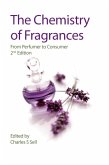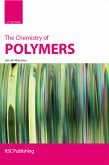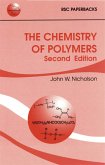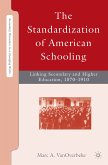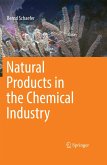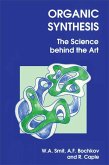The Chemistry of Fragrances (eBook, PDF)
Redaktion: Pybus, David; Sell, Charles
23,95 €
23,95 €
inkl. MwSt.
Sofort per Download lieferbar

12 °P sammeln
23,95 €
Als Download kaufen

23,95 €
inkl. MwSt.
Sofort per Download lieferbar

12 °P sammeln
Jetzt verschenken
Alle Infos zum eBook verschenken
23,95 €
inkl. MwSt.
Sofort per Download lieferbar
Alle Infos zum eBook verschenken

12 °P sammeln
The Chemistry of Fragrances (eBook, PDF)
Redaktion: Pybus, David; Sell, Charles
- Format: PDF
- Merkliste
- Auf die Merkliste
- Bewerten Bewerten
- Teilen
- Produkt teilen
- Produkterinnerung
- Produkterinnerung

Bitte loggen Sie sich zunächst in Ihr Kundenkonto ein oder registrieren Sie sich bei
bücher.de, um das eBook-Abo tolino select nutzen zu können.
Hier können Sie sich einloggen
Hier können Sie sich einloggen
Sie sind bereits eingeloggt. Klicken Sie auf 2. tolino select Abo, um fortzufahren.

Bitte loggen Sie sich zunächst in Ihr Kundenkonto ein oder registrieren Sie sich bei bücher.de, um das eBook-Abo tolino select nutzen zu können.
Modern perfumery is a blend of art, science and technology, with chemistry being the central science involved. The Chemistry of Fragrances aims to educate and entertain, and inform the audience of the very latest chemistry, techniques and tools applied to fragrance creativity. Beginning with the history of perfumes, which goes back over fifty thousand years, the book goes on to discuss the structure of the Perfume Industry today. The focus then turns to an imaginary brief to create a perfume, and the response to it, including that of the chemist and the creative perfumer. Consumer research,…mehr
- Geräte: PC
- mit Kopierschutz
- eBook Hilfe
- Größe: 4.16MB
Andere Kunden interessierten sich auch für
![Chemistry of Fragrances (eBook, PDF) Chemistry of Fragrances (eBook, PDF)]() Chemistry of Fragrances (eBook, PDF)35,95 €
Chemistry of Fragrances (eBook, PDF)35,95 €![The Chemistry of Polymers (eBook, PDF) The Chemistry of Polymers (eBook, PDF)]() John W NicholsonThe Chemistry of Polymers (eBook, PDF)34,95 €
John W NicholsonThe Chemistry of Polymers (eBook, PDF)34,95 €![The Chemistry of Polymers (eBook, PDF) The Chemistry of Polymers (eBook, PDF)]() John W NicholsonThe Chemistry of Polymers (eBook, PDF)23,95 €
John W NicholsonThe Chemistry of Polymers (eBook, PDF)23,95 €![Private Higher Education in Post-Communist Europe (eBook, PDF) Private Higher Education in Post-Communist Europe (eBook, PDF)]() Private Higher Education in Post-Communist Europe (eBook, PDF)73,95 €
Private Higher Education in Post-Communist Europe (eBook, PDF)73,95 €![The Standardization of American Schooling (eBook, PDF) The Standardization of American Schooling (eBook, PDF)]() M. VanoverbekeThe Standardization of American Schooling (eBook, PDF)40,95 €
M. VanoverbekeThe Standardization of American Schooling (eBook, PDF)40,95 €![Natural Products in the Chemical Industry (eBook, PDF) Natural Products in the Chemical Industry (eBook, PDF)]() Bernd SchaeferNatural Products in the Chemical Industry (eBook, PDF)105,95 €
Bernd SchaeferNatural Products in the Chemical Industry (eBook, PDF)105,95 €![Organic Synthesis (eBook, PDF) Organic Synthesis (eBook, PDF)]() W A SmitOrganic Synthesis (eBook, PDF)41,95 €
W A SmitOrganic Synthesis (eBook, PDF)41,95 €-
-
-
Modern perfumery is a blend of art, science and technology, with chemistry being the central science involved. The Chemistry of Fragrances aims to educate and entertain, and inform the audience of the very latest chemistry, techniques and tools applied to fragrance creativity. Beginning with the history of perfumes, which goes back over fifty thousand years, the book goes on to discuss the structure of the Perfume Industry today. The focus then turns to an imaginary brief to create a perfume, and the response to it, including that of the chemist and the creative perfumer. Consumer research, toxicological concerns, and the use of the electronic nose are some of the topics discussed on this journey of discovery. Written by respected experts in their fields, this unique book gives an insider view of ""mixing molecules"" from behind the portals of modern-day alchemy. It will be enjoyed by chemists and marketeers at all levels.
Dieser Download kann aus rechtlichen Gründen nur mit Rechnungsadresse in A, D ausgeliefert werden.
Produktdetails
- Produktdetails
- Verlag: RSC
- Seitenzahl: 294
- Erscheinungstermin: 31. Oktober 2007
- Englisch
- ISBN-13: 9781847552044
- Artikelnr.: 44757932
- Verlag: RSC
- Seitenzahl: 294
- Erscheinungstermin: 31. Oktober 2007
- Englisch
- ISBN-13: 9781847552044
- Artikelnr.: 44757932
- Herstellerkennzeichnung Die Herstellerinformationen sind derzeit nicht verfügbar.
Charles Sell is a Visiting Scientist at Massachusetts Institute of Technology, Boston and has 30 years' research experience in fragrance with Quest International.
Acknowledgement
Glossary
Chapter 1: The Human Relationship with Fragrance
Chapter 2: The History of Aroma Chemistry and Perfume
2.1: Early Use of Fragrance
2.2: The Age of Chivalry
2.3: The Age of Alchemy
2.4: The Age of Discovery
2.5: The Age of Revolution
2.6: The Age of Empire (Nineteenth Century)
2.7: The Age of Fashion (Twentieth Century)
Chapter 3: Perfumery Materials of Natural Origin
3.1: Perfumes and Odours in Nature
3.2: Extraction of Natural Perfume Ingredients
3.3: Adulteration of Natural Perfume Ingredients
3.4: From Natural to Synthetic
References
Chapter 4: Ingredients for the Modern Perfumery Industry
4.1: Economic Factors Affecting Perfume Ingredient Production
4.2: Perfume Ingredients Derived from Terpenoids
4.3: Musks
4.4: Perfume Ingredients Derived from Benzene
4.5: Perfume Ingredients Derived from Toluene
4.6: Perfume Ingredients Derived from Phenol
4.7: Pefrume Ingredients Derived from Naphthalene
4.8: Perfume Ingredients Derived from Aliphatic Materials
4.9: Perfume Ingredients Derived from Cyclopentanone
4.10: Perfume Ingredients Derived from Dicyclopentadiene
4.11: Conclusions
References
Chapter 5: The Structure of an International Fragrance Company
5.1: The Business-Getting Chain
5.2: The Supply Chain
References
Chapter 6: The Perfume Brief
6.1: Brief for Eve - Prepared by Business Scents Ltd
6.2: Toxicology
Chapter 7: Perfumer Creation: The Role of the Perfumer
7.1: Soap
7.2: Shampoo
7.3: Shower and Bath Gel
7.4: Antiperspirant
Reference
Chapter 8: Measurement of Fragrance Perception
8.1: Introduction
8.2: Market Research
8.3: Sensory Analysis
8.4: Multisensory Approach
8.5: Psychology of Perfume
8.6: The Business Scents Brief
8.7: Analysis of Ingredients to Convey the Appropriate Odour Characteristics
8.8: Creating Fragrances for the Future
References
Chapter 9: The Application of Fragrance
9.1: The Role of the Applications Department
9.2: Product Formulations
9.3: Stability Testing
References
Chapter 10: The Safety and Toxicology of Fragrances
10.1: Introduction
10.2: Self Regulation
10.3: Safety Assessment
10.4: Skin Irritation
10.5: Skin Sensitisation
10.6: Photoeffects
10.7: Neurotoxicity
10.8: Reproductive Effects
10.9: Natural Ingredients
10.10: Conclusions
References
Chapter 11: Volatility and Substantivity
11.1: Perfume Creation and Physical Chemistry
11.2: Perfume Ingredient Volatility
11.3: Perfume Polarity
11.4: Substantivity and Retention
11.5: Conclusions
References
Chapter 12: Natural Product Analysis in the Fragrance Industry
12.1: Introduction
12.2: Natural Product Analysis
12.3: Analytical Techniques used in the Fragrance Industry
12.4: Positive Identification
12.5: Headspace Collection
12.6: The Future
References
Chapter 13: Chemoreception
13.1: Why have a Sense of Smell?
13.2: Measuring Smell
13.3: Cell Wall Structure
13.4: Proteins Involved in Signal Generation
13.5: Anatomy of Smell
13.6: Signal Generation
13.7: The Combinatorial Nature of Odour Perception
13.8: Signal Processing
13.9: Implications for Odorant Design
References
Chapter 14: The Search for New Ingredients
14.1: Introduction
14.2: The Need
14.3: The Search
14.4: Computer-Aided Design Approach
14.5: Summary
Acknowledgements
References
Chapter 15: Buying Fragrance Ingredients and Selling Fragrance Compounds
15.1: Buying
15.2: Sales and Marketing
Chapter 16: The Finale: Brief Submission
Appendix I: Some of the more Important Natural Fragrance Materials
Appendix II: Useful Addresses
Bibliography
Subject Index
Glossary
Chapter 1: The Human Relationship with Fragrance
Chapter 2: The History of Aroma Chemistry and Perfume
2.1: Early Use of Fragrance
2.2: The Age of Chivalry
2.3: The Age of Alchemy
2.4: The Age of Discovery
2.5: The Age of Revolution
2.6: The Age of Empire (Nineteenth Century)
2.7: The Age of Fashion (Twentieth Century)
Chapter 3: Perfumery Materials of Natural Origin
3.1: Perfumes and Odours in Nature
3.2: Extraction of Natural Perfume Ingredients
3.3: Adulteration of Natural Perfume Ingredients
3.4: From Natural to Synthetic
References
Chapter 4: Ingredients for the Modern Perfumery Industry
4.1: Economic Factors Affecting Perfume Ingredient Production
4.2: Perfume Ingredients Derived from Terpenoids
4.3: Musks
4.4: Perfume Ingredients Derived from Benzene
4.5: Perfume Ingredients Derived from Toluene
4.6: Perfume Ingredients Derived from Phenol
4.7: Pefrume Ingredients Derived from Naphthalene
4.8: Perfume Ingredients Derived from Aliphatic Materials
4.9: Perfume Ingredients Derived from Cyclopentanone
4.10: Perfume Ingredients Derived from Dicyclopentadiene
4.11: Conclusions
References
Chapter 5: The Structure of an International Fragrance Company
5.1: The Business-Getting Chain
5.2: The Supply Chain
References
Chapter 6: The Perfume Brief
6.1: Brief for Eve - Prepared by Business Scents Ltd
6.2: Toxicology
Chapter 7: Perfumer Creation: The Role of the Perfumer
7.1: Soap
7.2: Shampoo
7.3: Shower and Bath Gel
7.4: Antiperspirant
Reference
Chapter 8: Measurement of Fragrance Perception
8.1: Introduction
8.2: Market Research
8.3: Sensory Analysis
8.4: Multisensory Approach
8.5: Psychology of Perfume
8.6: The Business Scents Brief
8.7: Analysis of Ingredients to Convey the Appropriate Odour Characteristics
8.8: Creating Fragrances for the Future
References
Chapter 9: The Application of Fragrance
9.1: The Role of the Applications Department
9.2: Product Formulations
9.3: Stability Testing
References
Chapter 10: The Safety and Toxicology of Fragrances
10.1: Introduction
10.2: Self Regulation
10.3: Safety Assessment
10.4: Skin Irritation
10.5: Skin Sensitisation
10.6: Photoeffects
10.7: Neurotoxicity
10.8: Reproductive Effects
10.9: Natural Ingredients
10.10: Conclusions
References
Chapter 11: Volatility and Substantivity
11.1: Perfume Creation and Physical Chemistry
11.2: Perfume Ingredient Volatility
11.3: Perfume Polarity
11.4: Substantivity and Retention
11.5: Conclusions
References
Chapter 12: Natural Product Analysis in the Fragrance Industry
12.1: Introduction
12.2: Natural Product Analysis
12.3: Analytical Techniques used in the Fragrance Industry
12.4: Positive Identification
12.5: Headspace Collection
12.6: The Future
References
Chapter 13: Chemoreception
13.1: Why have a Sense of Smell?
13.2: Measuring Smell
13.3: Cell Wall Structure
13.4: Proteins Involved in Signal Generation
13.5: Anatomy of Smell
13.6: Signal Generation
13.7: The Combinatorial Nature of Odour Perception
13.8: Signal Processing
13.9: Implications for Odorant Design
References
Chapter 14: The Search for New Ingredients
14.1: Introduction
14.2: The Need
14.3: The Search
14.4: Computer-Aided Design Approach
14.5: Summary
Acknowledgements
References
Chapter 15: Buying Fragrance Ingredients and Selling Fragrance Compounds
15.1: Buying
15.2: Sales and Marketing
Chapter 16: The Finale: Brief Submission
Appendix I: Some of the more Important Natural Fragrance Materials
Appendix II: Useful Addresses
Bibliography
Subject Index
Acknowledgement
Glossary
Chapter 1: The Human Relationship with Fragrance
Chapter 2: The History of Aroma Chemistry and Perfume
2.1: Early Use of Fragrance
2.2: The Age of Chivalry
2.3: The Age of Alchemy
2.4: The Age of Discovery
2.5: The Age of Revolution
2.6: The Age of Empire (Nineteenth Century)
2.7: The Age of Fashion (Twentieth Century)
Chapter 3: Perfumery Materials of Natural Origin
3.1: Perfumes and Odours in Nature
3.2: Extraction of Natural Perfume Ingredients
3.3: Adulteration of Natural Perfume Ingredients
3.4: From Natural to Synthetic
References
Chapter 4: Ingredients for the Modern Perfumery Industry
4.1: Economic Factors Affecting Perfume Ingredient Production
4.2: Perfume Ingredients Derived from Terpenoids
4.3: Musks
4.4: Perfume Ingredients Derived from Benzene
4.5: Perfume Ingredients Derived from Toluene
4.6: Perfume Ingredients Derived from Phenol
4.7: Pefrume Ingredients Derived from Naphthalene
4.8: Perfume Ingredients Derived from Aliphatic Materials
4.9: Perfume Ingredients Derived from Cyclopentanone
4.10: Perfume Ingredients Derived from Dicyclopentadiene
4.11: Conclusions
References
Chapter 5: The Structure of an International Fragrance Company
5.1: The Business-Getting Chain
5.2: The Supply Chain
References
Chapter 6: The Perfume Brief
6.1: Brief for Eve - Prepared by Business Scents Ltd
6.2: Toxicology
Chapter 7: Perfumer Creation: The Role of the Perfumer
7.1: Soap
7.2: Shampoo
7.3: Shower and Bath Gel
7.4: Antiperspirant
Reference
Chapter 8: Measurement of Fragrance Perception
8.1: Introduction
8.2: Market Research
8.3: Sensory Analysis
8.4: Multisensory Approach
8.5: Psychology of Perfume
8.6: The Business Scents Brief
8.7: Analysis of Ingredients to Convey the Appropriate Odour Characteristics
8.8: Creating Fragrances for the Future
References
Chapter 9: The Application of Fragrance
9.1: The Role of the Applications Department
9.2: Product Formulations
9.3: Stability Testing
References
Chapter 10: The Safety and Toxicology of Fragrances
10.1: Introduction
10.2: Self Regulation
10.3: Safety Assessment
10.4: Skin Irritation
10.5: Skin Sensitisation
10.6: Photoeffects
10.7: Neurotoxicity
10.8: Reproductive Effects
10.9: Natural Ingredients
10.10: Conclusions
References
Chapter 11: Volatility and Substantivity
11.1: Perfume Creation and Physical Chemistry
11.2: Perfume Ingredient Volatility
11.3: Perfume Polarity
11.4: Substantivity and Retention
11.5: Conclusions
References
Chapter 12: Natural Product Analysis in the Fragrance Industry
12.1: Introduction
12.2: Natural Product Analysis
12.3: Analytical Techniques used in the Fragrance Industry
12.4: Positive Identification
12.5: Headspace Collection
12.6: The Future
References
Chapter 13: Chemoreception
13.1: Why have a Sense of Smell?
13.2: Measuring Smell
13.3: Cell Wall Structure
13.4: Proteins Involved in Signal Generation
13.5: Anatomy of Smell
13.6: Signal Generation
13.7: The Combinatorial Nature of Odour Perception
13.8: Signal Processing
13.9: Implications for Odorant Design
References
Chapter 14: The Search for New Ingredients
14.1: Introduction
14.2: The Need
14.3: The Search
14.4: Computer-Aided Design Approach
14.5: Summary
Acknowledgements
References
Chapter 15: Buying Fragrance Ingredients and Selling Fragrance Compounds
15.1: Buying
15.2: Sales and Marketing
Chapter 16: The Finale: Brief Submission
Appendix I: Some of the more Important Natural Fragrance Materials
Appendix II: Useful Addresses
Bibliography
Subject Index
Glossary
Chapter 1: The Human Relationship with Fragrance
Chapter 2: The History of Aroma Chemistry and Perfume
2.1: Early Use of Fragrance
2.2: The Age of Chivalry
2.3: The Age of Alchemy
2.4: The Age of Discovery
2.5: The Age of Revolution
2.6: The Age of Empire (Nineteenth Century)
2.7: The Age of Fashion (Twentieth Century)
Chapter 3: Perfumery Materials of Natural Origin
3.1: Perfumes and Odours in Nature
3.2: Extraction of Natural Perfume Ingredients
3.3: Adulteration of Natural Perfume Ingredients
3.4: From Natural to Synthetic
References
Chapter 4: Ingredients for the Modern Perfumery Industry
4.1: Economic Factors Affecting Perfume Ingredient Production
4.2: Perfume Ingredients Derived from Terpenoids
4.3: Musks
4.4: Perfume Ingredients Derived from Benzene
4.5: Perfume Ingredients Derived from Toluene
4.6: Perfume Ingredients Derived from Phenol
4.7: Pefrume Ingredients Derived from Naphthalene
4.8: Perfume Ingredients Derived from Aliphatic Materials
4.9: Perfume Ingredients Derived from Cyclopentanone
4.10: Perfume Ingredients Derived from Dicyclopentadiene
4.11: Conclusions
References
Chapter 5: The Structure of an International Fragrance Company
5.1: The Business-Getting Chain
5.2: The Supply Chain
References
Chapter 6: The Perfume Brief
6.1: Brief for Eve - Prepared by Business Scents Ltd
6.2: Toxicology
Chapter 7: Perfumer Creation: The Role of the Perfumer
7.1: Soap
7.2: Shampoo
7.3: Shower and Bath Gel
7.4: Antiperspirant
Reference
Chapter 8: Measurement of Fragrance Perception
8.1: Introduction
8.2: Market Research
8.3: Sensory Analysis
8.4: Multisensory Approach
8.5: Psychology of Perfume
8.6: The Business Scents Brief
8.7: Analysis of Ingredients to Convey the Appropriate Odour Characteristics
8.8: Creating Fragrances for the Future
References
Chapter 9: The Application of Fragrance
9.1: The Role of the Applications Department
9.2: Product Formulations
9.3: Stability Testing
References
Chapter 10: The Safety and Toxicology of Fragrances
10.1: Introduction
10.2: Self Regulation
10.3: Safety Assessment
10.4: Skin Irritation
10.5: Skin Sensitisation
10.6: Photoeffects
10.7: Neurotoxicity
10.8: Reproductive Effects
10.9: Natural Ingredients
10.10: Conclusions
References
Chapter 11: Volatility and Substantivity
11.1: Perfume Creation and Physical Chemistry
11.2: Perfume Ingredient Volatility
11.3: Perfume Polarity
11.4: Substantivity and Retention
11.5: Conclusions
References
Chapter 12: Natural Product Analysis in the Fragrance Industry
12.1: Introduction
12.2: Natural Product Analysis
12.3: Analytical Techniques used in the Fragrance Industry
12.4: Positive Identification
12.5: Headspace Collection
12.6: The Future
References
Chapter 13: Chemoreception
13.1: Why have a Sense of Smell?
13.2: Measuring Smell
13.3: Cell Wall Structure
13.4: Proteins Involved in Signal Generation
13.5: Anatomy of Smell
13.6: Signal Generation
13.7: The Combinatorial Nature of Odour Perception
13.8: Signal Processing
13.9: Implications for Odorant Design
References
Chapter 14: The Search for New Ingredients
14.1: Introduction
14.2: The Need
14.3: The Search
14.4: Computer-Aided Design Approach
14.5: Summary
Acknowledgements
References
Chapter 15: Buying Fragrance Ingredients and Selling Fragrance Compounds
15.1: Buying
15.2: Sales and Marketing
Chapter 16: The Finale: Brief Submission
Appendix I: Some of the more Important Natural Fragrance Materials
Appendix II: Useful Addresses
Bibliography
Subject Index

